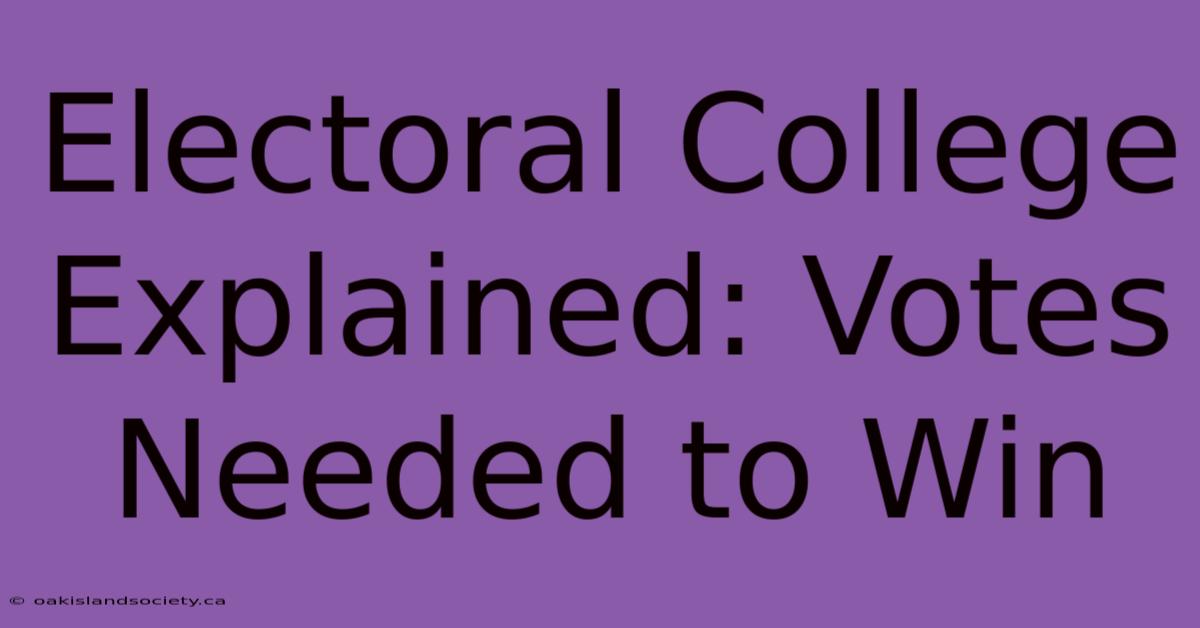Electoral College Explained: Votes Needed to Win
Have you ever wondered how a candidate can win the popular vote but still lose the presidency? The answer lies in the Electoral College, a complex system that has sparked debate for centuries. This article delves into the mechanics of the Electoral College, exploring the number of votes needed to secure victory and the intricacies of its operation.
Why This Topic Matters:
Understanding the Electoral College is crucial for informed political engagement. It affects the way we vote, the strategies employed by campaigns, and ultimately, the outcome of presidential elections. This article provides a clear overview of the Electoral College, addressing key aspects like the distribution of votes, the magic number needed to win, and the historical and contemporary debates surrounding this system.
Key Takeaways:
| Feature | Explanation |
|---|---|
| Electoral Votes: | Each state receives a number of electoral votes based on its total congressional representation (House of Representatives + Senate). |
| Winning the Presidency: | A candidate needs a majority of electoral votes (at least 270 out of 538) to win the presidency. |
| Popular Vote vs. Electoral Vote: | A candidate can win the popular vote but lose the electoral vote, and vice versa. |
| Swing States: | States with a close balance of Democratic and Republican voters are crucial in presidential elections, often determining the outcome. |
| Faithless Electors: | While rare, there are cases where electors vote for someone other than the candidate they are pledged to support. |
Electoral College Explained:
The Electoral College was established by the Founding Fathers to address concerns about direct democracy and to balance the power of larger states. This system aims to ensure representation for all states, not just the most populous ones.
Key Aspects:
- Electoral Votes: Each state is assigned a number of electoral votes equal to its total congressional representation (House of Representatives + Senate). Additionally, the District of Columbia receives three electoral votes, based on the 23rd Amendment.
- Winning the Election: A candidate needs to secure at least 270 electoral votes to win the presidency. This represents a majority of the total 538 electoral votes.
- Popular Vote: A candidate can win the popular vote but lose the electoral vote, and vice versa. This happens because the Electoral College system allocates votes on a state-by-state basis, not based on the overall number of votes cast nationwide.
- Swing States: States with a close balance of Democratic and Republican voters are known as swing states. They often hold the key to winning presidential elections, as their electoral votes can significantly influence the outcome.
- Faithless Electors: While rare, there are cases where electors vote for someone other than the candidate they are pledged to support. These "faithless electors" can theoretically change the outcome of an election, but they are generally considered an anomaly.
The Magic Number: 270
Winning 270 electoral votes is the goal for any presidential candidate. This number represents a majority of the total 538 electoral votes. To achieve this, candidates often focus on swing states where the outcome is uncertain.
How it Works:
- Electors: Each state chooses electors based on its electoral vote count. These electors are typically pledged to vote for a particular candidate.
- State-by-State Voting: Voters in each state choose the candidate they prefer. The candidate who wins the popular vote in a state typically receives all of that state's electoral votes.
- Electoral College Vote: On Election Day, the electors chosen by each state vote for their chosen candidate. The candidate who receives a majority of electoral votes (at least 270) wins the presidency.
Debates and Criticisms:
The Electoral College has been a source of controversy for decades.
Points of contention:
- Winner Takes All: The "winner-takes-all" system in most states means that the candidate who wins the popular vote in a state receives all of that state's electoral votes, regardless of the margin of victory. This can result in a candidate winning the presidency even if they lose the popular vote.
- Underrepresentation: The system has been criticized for underrepresenting the votes of citizens in states where one party consistently wins.
- Faithless Electors: While rare, faithless electors have the potential to undermine the will of the voters.
Conclusion:
The Electoral College remains a contentious system, with passionate arguments both for and against its continued existence. It's crucial to understand the intricacies of this system to engage in informed political discourse and to navigate the complex landscape of presidential elections.
While the Electoral College ensures representation for all states, some argue that it undermines the democratic principle of "one person, one vote." The ongoing debate surrounding this system highlights the importance of understanding its mechanics and considering its impact on the American political landscape.

